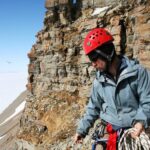We’re all familiar with the stereotypical image of the lone scientist, slaving away (usually in the lab) for years to produce game-changing results that earn them the Nobel Prize. Nobel prizes aside, however, science doesn’t occur in a vacuum. As much as it may seem otherwise, science is a highly social activity.
It’s important for researchers to publish solo work. It shows they can work alone to solve complex problems, and cements their reputation as a good scientist. However, collaboration can take your research in new directions you may never have considered.
Collaboration can occur organically, where you run across someone doing interesting stuff related to your research, and you decide to work together. I know several people who have connected informally via Twitter and are now publishing together. Collaboration can also be fostered by an individual who decides to hand-pick members of a research team—for example at a business or research institute, where the CEO wants specific people to collaborate on a particular project.
Collaboration is in some cases mandated by a larger community that creates common research methodologies and data standards. For example, the 2007-08 Canadian International Polar Year initiative funded all projects from the same financial pot, required collaboration with other international projects of relevance, and developed data standards to which all research teams were expected to adhere.
In other cases, collaboration is the optimal way to operate when researchers require access to the same resources, such as ship time, plane transport, or satellites.
Collaboration occurs throughout your research career. At first you’ll likely collaborate with your thesis supervisor, other people in your research group, and perhaps fellow graduate students in related fields.
For grad students, the AAAS has a program called Emerging Leaders in Science & Society (ELISS), where they bring students together to collaborate across disciplinary boundaries. Here in Canada, the conservation biology community has organized student ‘research derbies’: “a collaborative and semi-competitive workshop where teams are given 24 hours to complete a research project.” A derby based at the University of Victoria in 2014 resulted in a collaborative publication about Canadian species at risk in the journal PLOSOne.
As you move out into the research world, however—whether that’s in academia, industry, government or NGOs—you’ll have an entirely new pool of potential collaborators. These include other researchers at your institution, citizen scientists, researchers at other institutions, and more.
As a new scientist, collaboration is a good way to build personal connections with members of your research community. These relationships are critical because those same people will review your grant proposals and journal manuscripts. If they know you and think favourably of you, they’re more likely to support your work. In fact, one study has shown that the extent of the network of people in your research community that you know and work with (your personal ‘reach’), is a good predictor of whether or not you’ll stay at your university and get promoted.
It’s important, however, to consider a few things before jumping wholeheartedly into a collaborative project.
- It goes without saying that you should build collaborations with people you’re comfortable working with: This will help immensely when you have to bridge disciplinary divides or make difficult project decisions.
- Be clear from the outset who is responsible for specific aspects of the research project.
- Make sure you have group consensus on what the project outcomes will be.
- Agree on more picky details such as how you’ll order the list of co-authors on each project publication: Good advice on co-authorship can be found in Stephen Heard’s book on scientific writing, reviewed here.
- Even the best collaborations may dissolve over time: It could be that participants have different goals, or that the project they came together for has finished.
Remember that collaboration isn’t all rainbows and unicorns. While you may develop good friendships with team members, it’s important to maintain an open door policy. All too often collaborations become entrenched groups disconnected from the larger research community, who may disparage similar work done by other research groups and be unreceptive to bringing on new members.
Additionally, while researchers often collaborate on interdisciplinary research projects, a recent study has shown that, the more interdisciplinary the research, the less likely it is to be funded.
If you’re a woman, you may be interested in a study from the field of Economics which showed that, when women collaborate with men, their tenure prospects do not improve, as the male collaborator is awarded the credit for the publication. A bibliometric research project examining men vs. women in collaborative research also showed that, even when a woman was in a prominent author position (single authorship, first- or last-authorship), her paper was cited less often than papers with men in those same authorship positions.
Despite these drawbacks, collaboration is a crucial part of scientific work. As long as you’re aware of the pros and cons, collaboration can give your research career a substantial boost, and help you make friends along the way.
This post benefitted from an online discussion by the C4Sci group, based on AAAS’s Trellis Science platform. Thanks to those who contributed to the discussion: Ian Street, Lou Woodley, Sara Parks, Ed Hackett, Joshua Young, Gabrielle Rabinowitz, Dan Richman, and John Palka.




